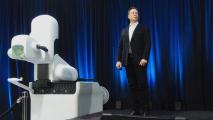UV robots can sterilize an ICU in 10 minutes
UV disinfection cleaning robots could make hospitals safer and cleaner than ever before. They’re a major step up from traditional human cleaning methods, which take more time, are less effective, and often miss crevices that can hide nasty bugs. This is an especially big deal for intensive care units and clean rooms for immunocompromised patients, and it’s possible that automated UV cleaning will soon become standard practice throughout the healthcare system.
Hospitals Save Lives—But… Hospitals are full of sick people, and that can make them dangerous places. Even worse, they are full of sick people on antibiotics, potentially culturing deadly drug-resistant infections. This makes sanitation a uniquely important challenge for healthcare workers and staff, and hospitals do the best they can to make sure that surfaces are sterilized. Unfortunately, there’s a ton of surface area to clean, and plenty of places for them to hide. In 2011, the CDC estimated there were 721,800 hospital-related infections and 75,000 deaths, with more than 40% coming from ICUs.
Quite a few infections come from staff failing to sterilize their hands or instruments properly, but many also come from microbes hiding out in nooks and crannies missed by human cleaners, such as the spaces between computer keys. Inevitably, some will even survive the cleaning solutions, too. Bacteria are surprisingly resilient and adaptive. For instance, earlier this year, NASA discovered that germs in their sterile spacecraft-assembly rooms were actually feeding on the disinfectants meant to kill them.
Sunlight Is the Best Disinfectant (Literally): A little bit of ultraviolent radiation from the sun will give you a tan, but UV rays also damage DNA, so over time too much sunlight will increase your risk of skin cancer. But we can leverage the DNA-shredding power of high-frequency electromagnetic waves for good, by using them to kill stuff that wants to kill us. For instance, X-rays and gamma rays are used to disinfect meat, vegetables, and spices, destroying mold, parasites, and bacteria (like E. coli and Salmonella) that can be hiding inside the food.
A bit further down the frequency scale, UV rays can be used to clean and sterilize surfaces. A number of companies make UV disinfecting tools, but Infection Prevention Technologies says their latest model—a big cylinder on wheels, covered with high-powered UV lights—can destroy all microorganisms in just ten minutes. The high-frequency rays are dialed in to the precise wavelength that damages DNA, breaking up even the toughest germs, like MRSA, from the inside out.
Lab cultures from real hospital ICUs have found zero bacteria in the room after running the disinfection robots for 20 minutes. As a bonus, UV rays reflect off walls and hard surfaces, allowing it to get behind and around some objects, for an exceptionally fast and thorough floor-to-ceiling clean. The ICUs still do traditional disinfecting, but the UV robot provides an extra layer of protection that cleaning by hand never could.
The Upshot: Hospital-related infections are a persistent problem, costing us billions of dollars a year and thousands of lives. They are an especially big danger to the most vulnerable patients, like premature infants, cancer patients, and the immunocompromised. By combining ordinary disinfection and UV irradiation, we can crush pathogens between a rock and a hard place. Use of UV sterilization in healthcare is only likely to grow from here, especially given the increasingly widespread use of automated robot services in hospitals.




